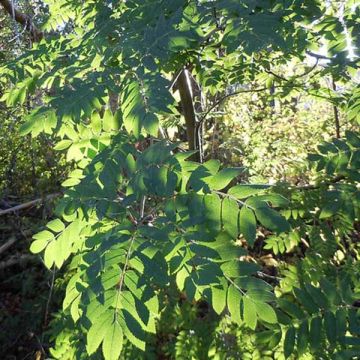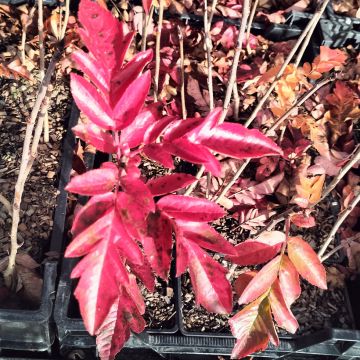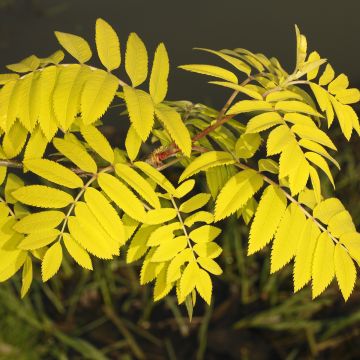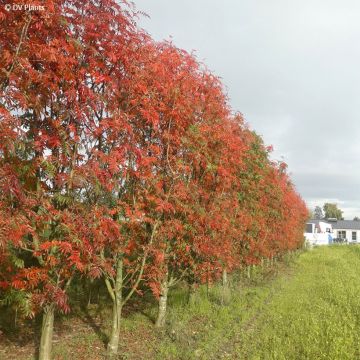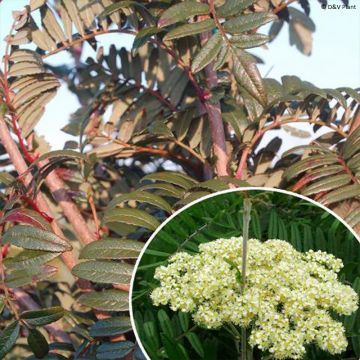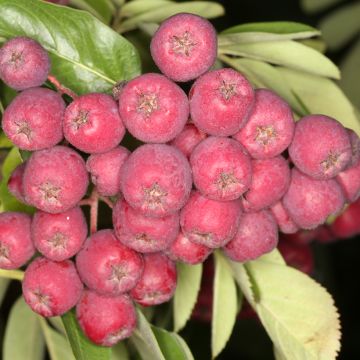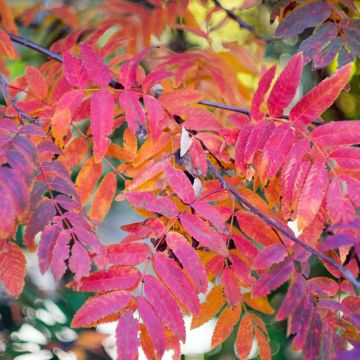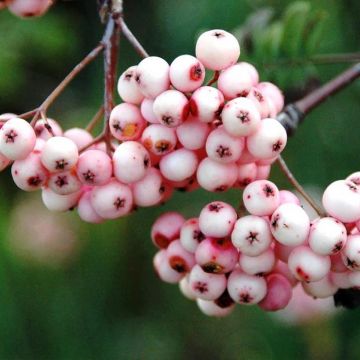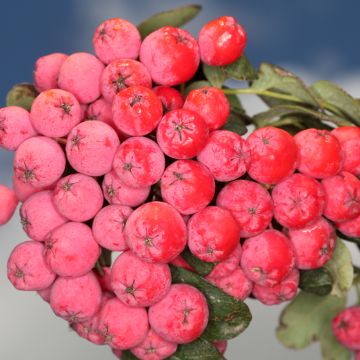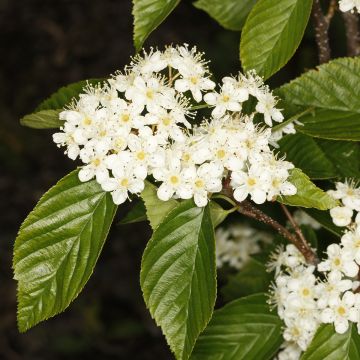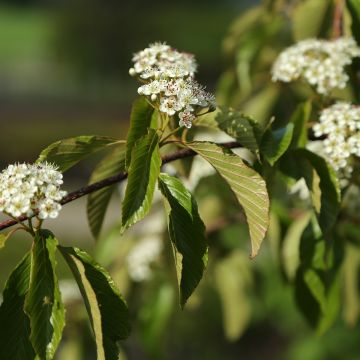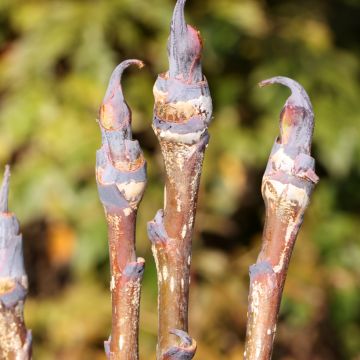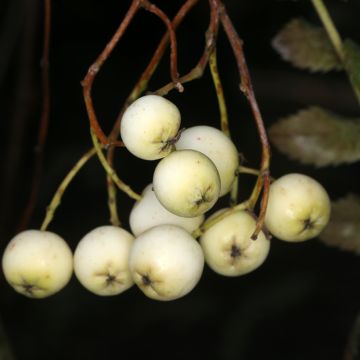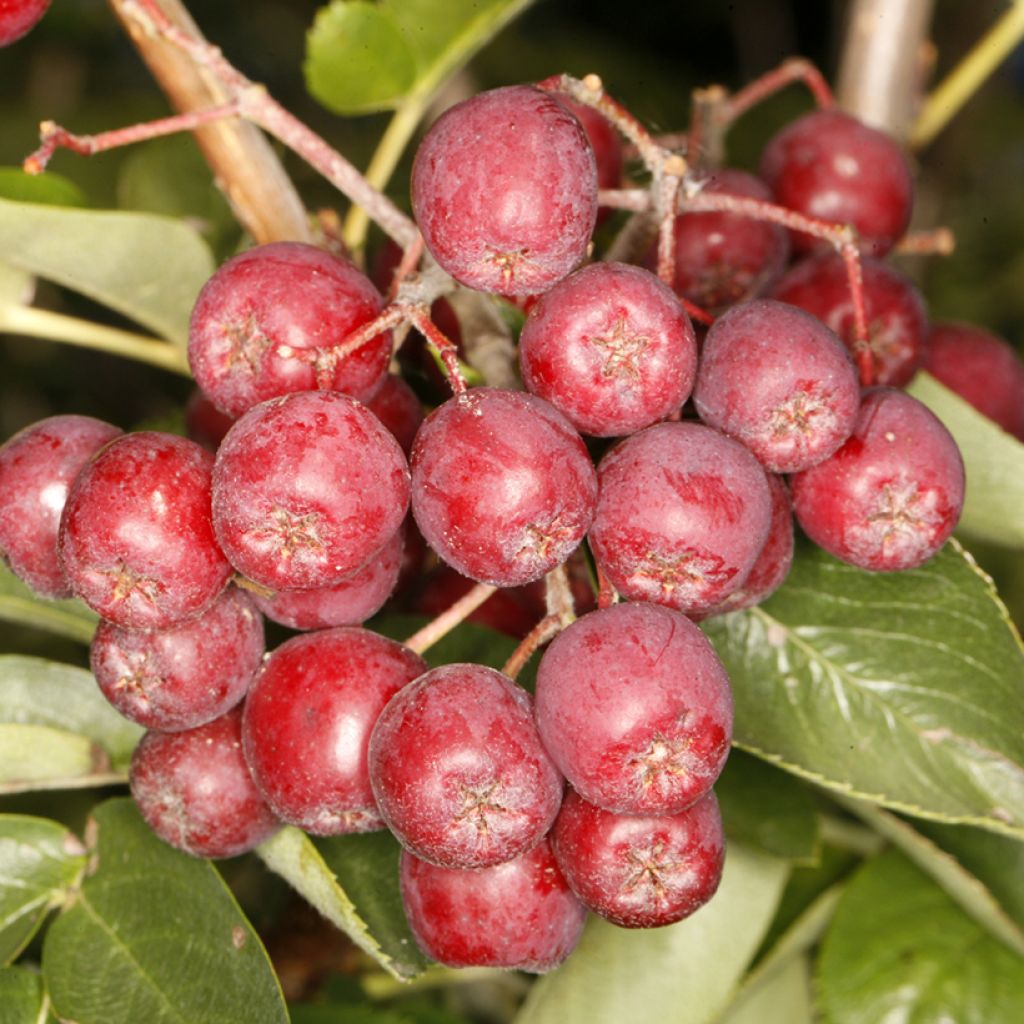

Sorbus aucuparia Alaja Krupnaja - Rowan
Sorbus aucuparia Alaja Krupnaja - Rowan
Sorbus aucuparia Alaja Krupnaja
Rowan, Mountain Ash
Why not try an alternative variety in stock?
View all →This plant carries a 24 months recovery warranty
More information
We guarantee the quality of our plants for a full growing cycle, and will replace at our expense any plant that fails to recover under normal climatic and planting conditions.
Oversize package: home delivery by special carrier from €6.90 per order..
Express home delivery from €8.90.
Does this plant fit my garden?
Set up your Plantfit profile →
Description
Sorbus aucuparia 'Alaja Krupnaja' is a Russian variety of Rowan that can be considered both an ornamental plant and a fruit tree. It forms a small to medium-sized tree with a rounded crown, whose branches are adorned with dark green compound leaves. In spring, it produces decorative white flowering in large umbels, which stand out well against the dark foliage. From September, clusters of red berries ripen, adding decorative appeal to this plant. They are edible and pleasant to taste. The foliage takes on beautiful autumnal colours of yellow-orange before falling. It is very hardy and easy to cultivate in most situations.
The Rowan is a member of the very large family of Rosaceae (approximately 5000 species), which includes both wild plants, such as brambles, ornamental plants (Filipendula, Photinia...) and most of our fruit trees (Pear, Peach...), some of which, like this Rowan, are also ornamental. The genus Sorbus, within which we distinguish the Rowans, with compound leaves, and the Service trees, with simple leaves, comprises over a hundred species. The rowan tree, or Sorbus aucuparia, is a boreal species, found in northern Europe up to Iceland, and in Asia, as far as Siberia and Japan. Often living less than 100 years, it forms a tree with an elegant pyramidal habit, usually less than 10 m tall, but occasionally exceeding 15 m.
'Alaja Krupnaja' is a variety with poorly known heritage; it may be a hybrid of Rowan X Pear, even though its general appearance is close to the botanical species. As an adult, the tree adopts a spreading and rounded crown, of medium density, pyramidal shape, wide and regular, reaching 5 to 6 m in height and 3 to 4 m in width. Slowing its growth after 20 m, it can nevertheless continue to rise and eventually reach a height of around ten metres. The branches bear odd-pinnate leaves, which means they are composed of leaflets in an odd number, arranged oppositely two by two along the leaf rib, with a single leaflet terminating the end of it. The leaflets have an elliptical shape and are finely toothed. They are a rather dark, slightly glossy green on the upper side, while the underside is paler, almost whitish, due to a downy covering.
This somewhat dark foliage highlights the flowering that appears from mid-May. Umbels of about 15 cm in diameter, consisting of small cream-white flowers, then form on the tree. They are decorative and honey-producing, giving this plant a utilitarian status for wildlife and honeybees. As this variety is self-fertile, the flowers develop each year, after 2 or 3 years of planting, into relatively large fruits for the species. The spherical berries measure 1.5 to 2 cm in diameter, grouped in large, clearly visible and ornamental clusters with their bright red colour, sometimes barely tinged with orange. These fruits, which ripen in September, have firm and juicy flesh; they are sweet-sour, sweet with a barely perceptible hint of bitterness. They can be eaten raw or made into jams, compotes, or jellies, or even as liqueur. This very fertile Rowan offers a magnificent end-of-season display adorned with these vibrant fruits, which are also enjoyed by birds.
Autumn is further enhanced by the late-season colours in yellow-orange tones, before the foliage falls, heralding the arrival of winter. In our climates, this will not harm this extremely hardy tree, which is also capable of adapting to most soils.
Rowan 'Alaja Krupnaja' is perfectly suited for small areas, particularly small urban gardens, due to its dimensions, and also because it withstands air pollution well. Its somewhat wild appearance and contribution to biodiversity make it an excellent choice for a country garden with a natural style. You can then associate it with other plants that share the same qualities, such as Amelanchier canadensis, a superb bush offering a lavish white spring flowering, followed by small red and then black berries, edible and enjoyed by birds, while its green foliage takes on stunning autumnal colours of red, yellow, orange, and purple. A botanical rose will blend naturally into your pastoral scene, such as the remarkable Rosa moyesii 'Geranium', with a bushy habit and producing simple cherry-red flowers in June, enhanced by a golden centre. In autumn, they produce large bright orange fruits that birds adore. Of course, other fruit trees can join your decor, Apple tree, Pear tree, Cherry tree, from which you will enjoy the fruits in spring or during winter...
Report an error about the product description
Plant habit
Flowering
Foliage
Botanical data
Sorbus
aucuparia
Alaja Krupnaja
Rosaceae
Rowan, Mountain Ash
Cultivar or hybrid
Other Sorbus - Mountain Ash
Planting and care
Sorbus aucuparia 'Alaja Krupnaja' is best planted in autumn in any soil, preferably moist (but it tolerates dry), slightly acidic to neutral (it also withstands limestone). Not demanding, it adapts to loamy, clayey, or sandy soils. In summary, it adapts to virtually all types of soils. Dig a planting hole 60 to 80 cm wide and add some compost to the bottom if the soil is really poor. Soak the container for a quarter of an hour in a bucket to thoroughly saturate the root ball before placing it in the planting hole. Backfill and water generously; water for the first two years to allow the tree to establish itself well.
It prefers to grow in full sun, also tolerating partial shade in very bright climates, and has no particular requirements. It is a pioneering species capable of establishing itself in poor soils, making it ideal for beginners in the garden.
Planting period
Intended location
Care
This item has not been reviewed yet - be the first to leave a review about it.
Haven't found what you were looking for?
Hardiness is the lowest winter temperature a plant can endure without suffering serious damage or even dying. However, hardiness is affected by location (a sheltered area, such as a patio), protection (winter cover) and soil type (hardiness is improved by well-drained soil).

Photo Sharing Terms & Conditions
In order to encourage gardeners to interact and share their experiences, Promesse de fleurs offers various media enabling content to be uploaded onto its Site - in particular via the ‘Photo sharing’ module.
The User agrees to refrain from:
- Posting any content that is illegal, prejudicial, insulting, racist, inciteful to hatred, revisionist, contrary to public decency, that infringes on privacy or on the privacy rights of third parties, in particular the publicity rights of persons and goods, intellectual property rights, or the right to privacy.
- Submitting content on behalf of a third party;
- Impersonate the identity of a third party and/or publish any personal information about a third party;
In general, the User undertakes to refrain from any unethical behaviour.
All Content (in particular text, comments, files, images, photos, videos, creative works, etc.), which may be subject to property or intellectual property rights, image or other private rights, shall remain the property of the User, subject to the limited rights granted by the terms of the licence granted by Promesse de fleurs as stated below. Users are at liberty to publish or not to publish such Content on the Site, notably via the ‘Photo Sharing’ facility, and accept that this Content shall be made public and freely accessible, notably on the Internet.
Users further acknowledge, undertake to have ,and guarantee that they hold all necessary rights and permissions to publish such material on the Site, in particular with regard to the legislation in force pertaining to any privacy, property, intellectual property, image, or contractual rights, or rights of any other nature. By publishing such Content on the Site, Users acknowledge accepting full liability as publishers of the Content within the meaning of the law, and grant Promesse de fleurs, free of charge, an inclusive, worldwide licence for the said Content for the entire duration of its publication, including all reproduction, representation, up/downloading, displaying, performing, transmission, and storage rights.
Users also grant permission for their name to be linked to the Content and accept that this link may not always be made available.
By engaging in posting material, Users consent to their Content becoming automatically accessible on the Internet, in particular on other sites and/or blogs and/or web pages of the Promesse de fleurs site, including in particular social pages and the Promesse de fleurs catalogue.
Users may secure the removal of entrusted content free of charge by issuing a simple request via our contact form.
The flowering period indicated on our website applies to countries and regions located in USDA zone 8 (France, the United Kingdom, Ireland, the Netherlands, etc.)
It will vary according to where you live:
- In zones 9 to 10 (Italy, Spain, Greece, etc.), flowering will occur about 2 to 4 weeks earlier.
- In zones 6 to 7 (Germany, Poland, Slovenia, and lower mountainous regions), flowering will be delayed by 2 to 3 weeks.
- In zone 5 (Central Europe, Scandinavia), blooming will be delayed by 3 to 5 weeks.
In temperate climates, pruning of spring-flowering shrubs (forsythia, spireas, etc.) should be done just after flowering.
Pruning of summer-flowering shrubs (Indian Lilac, Perovskia, etc.) can be done in winter or spring.
In cold regions as well as with frost-sensitive plants, avoid pruning too early when severe frosts may still occur.
The planting period indicated on our website applies to countries and regions located in USDA zone 8 (France, United Kingdom, Ireland, Netherlands).
It will vary according to where you live:
- In Mediterranean zones (Marseille, Madrid, Milan, etc.), autumn and winter are the best planting periods.
- In continental zones (Strasbourg, Munich, Vienna, etc.), delay planting by 2 to 3 weeks in spring and bring it forward by 2 to 4 weeks in autumn.
- In mountainous regions (the Alps, Pyrenees, Carpathians, etc.), it is best to plant in late spring (May-June) or late summer (August-September).
The harvesting period indicated on our website applies to countries and regions in USDA zone 8 (France, England, Ireland, the Netherlands).
In colder areas (Scandinavia, Poland, Austria...) fruit and vegetable harvests are likely to be delayed by 3-4 weeks.
In warmer areas (Italy, Spain, Greece, etc.), harvesting will probably take place earlier, depending on weather conditions.
The sowing periods indicated on our website apply to countries and regions within USDA Zone 8 (France, UK, Ireland, Netherlands).
In colder areas (Scandinavia, Poland, Austria...), delay any outdoor sowing by 3-4 weeks, or sow under glass.
In warmer climes (Italy, Spain, Greece, etc.), bring outdoor sowing forward by a few weeks.

































